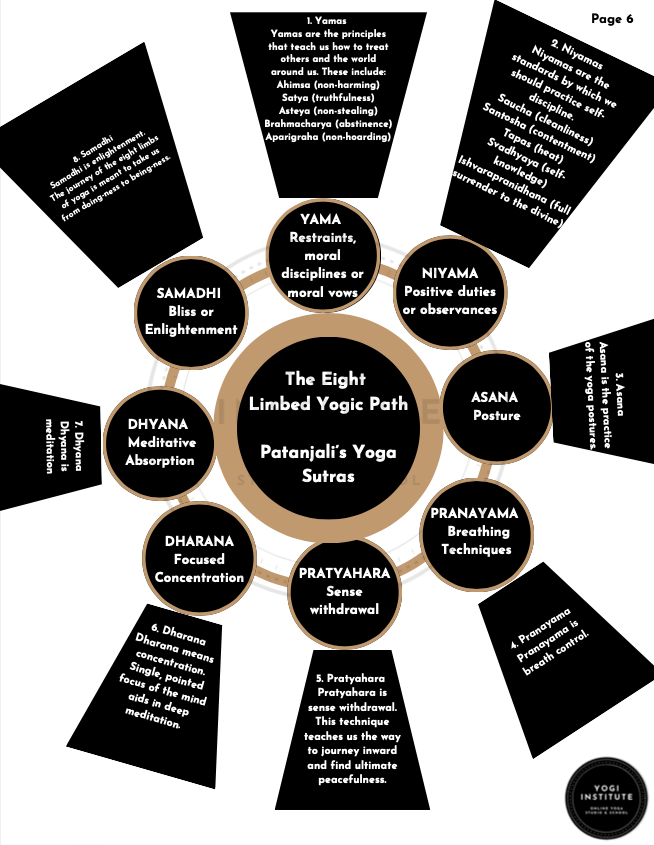Modern Day Applications Of Patanjeli’s 8 Limbed Yogic Path For Personal Growth
Patanjali's Eight-Limbed Yogic Path, also known as Ashtanga Yoga, offers a comprehensive framework for achieving holistic well-being and self-realization. While it was developed thousands of years ago, its principles can still be applied to modern-day life to promote physical, mental, and spiritual growth. Here's how you can adapt each limb of the path to contemporary living:
Yamas (Ethical Guidelines):
Ahimsa (Non-violence): Practice kindness, compassion, and non-violence towards yourself, others, and the environment. This can be applied through conscious consumption, reducing harm, and cultivating empathy.
Satya (Truthfulness): Be honest and authentic in your words and actions. Avoid spreading misinformation and work towards clear communication in personal and online interactions.
Asteya (Non-stealing): Respect others' property, time, and ideas. This translates into respecting copyrights, giving credit where due, and not taking more than you need.
Brahmacharya (Moderation): Strive for balance in all aspects of life, including work, relationships, and consumption. This can involve using technology mindfully and managing time effectively.
Aparigraha (Non-possessiveness): Detach from material possessions and avoid unnecessary accumulation. Embrace minimalism and share resources when possible.
Niyamas (Personal Observances):
Saucha (Cleanliness): Maintain physical and mental cleanliness through regular self-care routines and practices that promote mental clarity, such as mindfulness meditation.
Santosha (Contentment): Cultivate gratitude and find contentment in the present moment. Practice appreciating what you have rather than constantly seeking external validation or material gains.
Tapas (Discipline): Develop self-discipline to achieve personal and professional goals. This could include maintaining healthy habits, managing time effectively, and committing to self-improvement.
Svadhyaya (Self-study): Engage in self-reflection, self-awareness, and continuous learning. This can involve reading, journaling, and seeking personal growth through introspection.
Ishvara Pranidhana (Surrender to the Divine): Cultivate a sense of humility and acknowledge a higher power or purpose beyond yourself. This could be through mindfulness practices, prayer, or aligning with your values.
Asana (Physical Postures):
Engage in regular physical activity, including yoga poses and other forms of exercise, to maintain flexibility, strength, and overall physical well-being.
Pranayama (Breath Control):
Practice mindful breathing techniques to manage stress, increase focus, and promote relaxation. Incorporate deep breathing into daily routines, especially during moments of tension.
Pratyahara (Withdrawal of Senses):
Create periods of sensory withdrawal, such as during meditation or digital detoxes. Limit exposure to external stimuli and prioritize self-awareness.
Dharana (Concentration):
Enhance your focus and concentration by setting specific goals, managing distractions, and engaging in activities that require sustained attention.
Dhyana (Meditation):
Establish a regular meditation practice to cultivate mindfulness, inner peace, and mental clarity. Use guided meditation apps or techniques that resonate with you.
Samadhi (State of Transcendence):
Strive for moments of deep connection, self-awareness, and spiritual insight. Seek experiences that align with your values and allow you to feel a sense of unity with the world.
By adapting these principles to your daily life, you can integrate the wisdom of Patanjali's Eight-Limbed Yogic Path into a modern context, fostering personal growth, well-being, and a deeper understanding of your own self. Remember that the path is a journey, and it's okay to progress at your own pace while embracing the principles that resonate with you the most.


